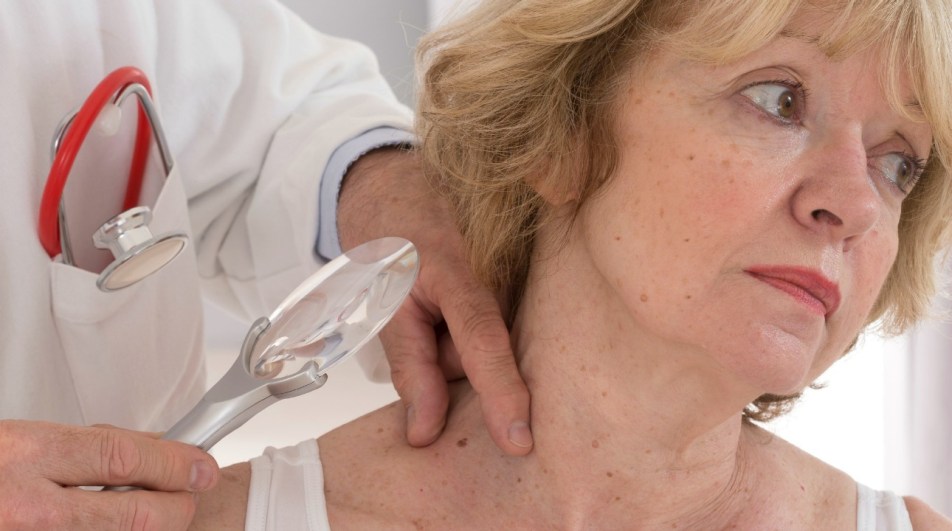What to Do If Skin Cancer Runs in Your Family

Every year, there are more new cases of skin cancer than breast, lung, colon, and prostate cancers combined, according to the Skin Cancer Foundation. About one in five Americans will get skin cancer by the age of 70, and the biggest risk factor is ultraviolet light — a type of radiation that comes from the sun.
While these statistics might sound scary, you’d be surprised to know that about 99 percent of skin cancers are basal or squamous cell carcinomas, which don’t usually spread to other organs and are only fatal if left untreated. That said, the third form of skin cancer is both the rarest and the deadliest. It’s called melanoma, and it makes up the majority of skin-cancer deaths.
Skin cancer, especially melanoma, can also run in families. To make sense of the research in this topic (and to figure out what to do if skin cancer runs in your family), we turned to Sancy Leachman, MD, director of the Knight Cancer Institute’s Melanoma Research Program at Oregon Health and Science University in Portland, Oregon. Scroll below to learn Dr. Leachman’s expert tips and advice.
Important Reminders If Skin Cancer Runs in Your Family
1. Some genetic mutations carry a higher risk than others. Luckily, they’re rare, but if you carry just one copy of the mutation (meaning you inherit a copy from either your mom or dad), your risk can go up 30 to 70 percent during your lifetime. The average person’s risk of getting melanoma is about 2 percent.
2. The most common genetic mutation is the gene responsible for red hair, light eyes, and freckles. Everyone has a gene that makes a brown pigment, and when you inherit the mutation that disables that ability, your body produces red pigment instead. This genetic mutation is pretty common; about 30 percent of people whose ancestors came from northern Europe carry at least one copy, even if they’re not redheads! It also makes you more vulnerable to the harmful effects of ultraviolet rays, so your risk of developing melanoma is twice to four times as high as the average person. You also have a higher risk of developing basal or squamous cell carcinomas.
3. Some of those high-risk mutations can cause other cancers. People who have a family history of melanoma also have a higher risk of developing pancreatic or breast cancer, depending on the mutation they have. “There’s a mutation called P16, which not only causes melanoma, but also increases your risk for pancreatic cancer,” says Leachman. “But there are other things going on, either in the environment or in other genes that are being inherited, that makes one family with P16 have more pancreatic cancer and another family with P16 have more melanoma. We have no proof of this, but maybe if you have a P16 mutation and live in a sunny place, you might have a tendency to get melanoma. But if you lived in a place where there were more toxins or you were a cigarette smoker, you might have a tendency to develop pancreatic cancer. We’re still in the process of figuring stuff out.”
4. Follow the “Rule of Threes” to determine if skin cancer runs in your family. The first: You’ve had three different invasive melanomas — meaning the tumor has penetrated deeper into the skin and possibly spread into other places in the body — or you’ve had a melanoma and pancreatic cancer. The second: You’ve had three or more first- or second-degree family members — all of whom are related by blood to you and to each other — who have had invasive melanoma. So your mom, aunt, and sister count. Your in-laws don’t — and people who’ve had the other two types of skin cancer aren’t included, either. The third: You’ve had two invasive melanomas and another type of cancer, like breast or pancreatic.
5. If you fall into any of the categories above, go to a genetic counselor. Very few people fall into this category, according to Leachman. “For these people, I absolutely recommend that they talk to a genetic counselor,” she said. “It can be potentially lifesaving because we’ve discovered that if they test positive for one of these mutations, they follow medical recommendations, and they get their relatives on board too.”
How to Prevent Skin Cancer If It Runs in Your Family
1. Protect your skin. When you’re out and about, don’t stand in the direct sunlight — go stand or sit in the shade. Cover up with clothing. “I I love clothing. It’s better than sunscreen — it doesn’t wear off or wash off,” says Leachman. Use sunscreen in the spots you can’t cover. She adds, “I like the sunscreens that are physical barriers only — zinc oxide and titanium oxide — those are the ones I use and recommend.”
2. Examine your skin from head to toe. Every month, look for unusual growths or moles. You’re looking for moles that are irregular on one side, have different colors, are the size of a pencil eraser, or have changed since last month. Ask a loved one to check hard-to-reach places such as your scalp, your back, or behind your legs.
3. See a doctor every year. A dermatologist can give you a total body exam.
Next, learn about the signs of breast cancer that have nothing to do with a lump in the video below:
More From FIRST
Moisturize Your Sad, Dry Hands While You’re Washing Dishes
11 Must-Have Retinol Cream Moisturizers for Flawless, Youthful Skin
Not Quite a Freckle, Not Quite a Mole: Are Those Brown Spots Seborrheic Keratoses?
















